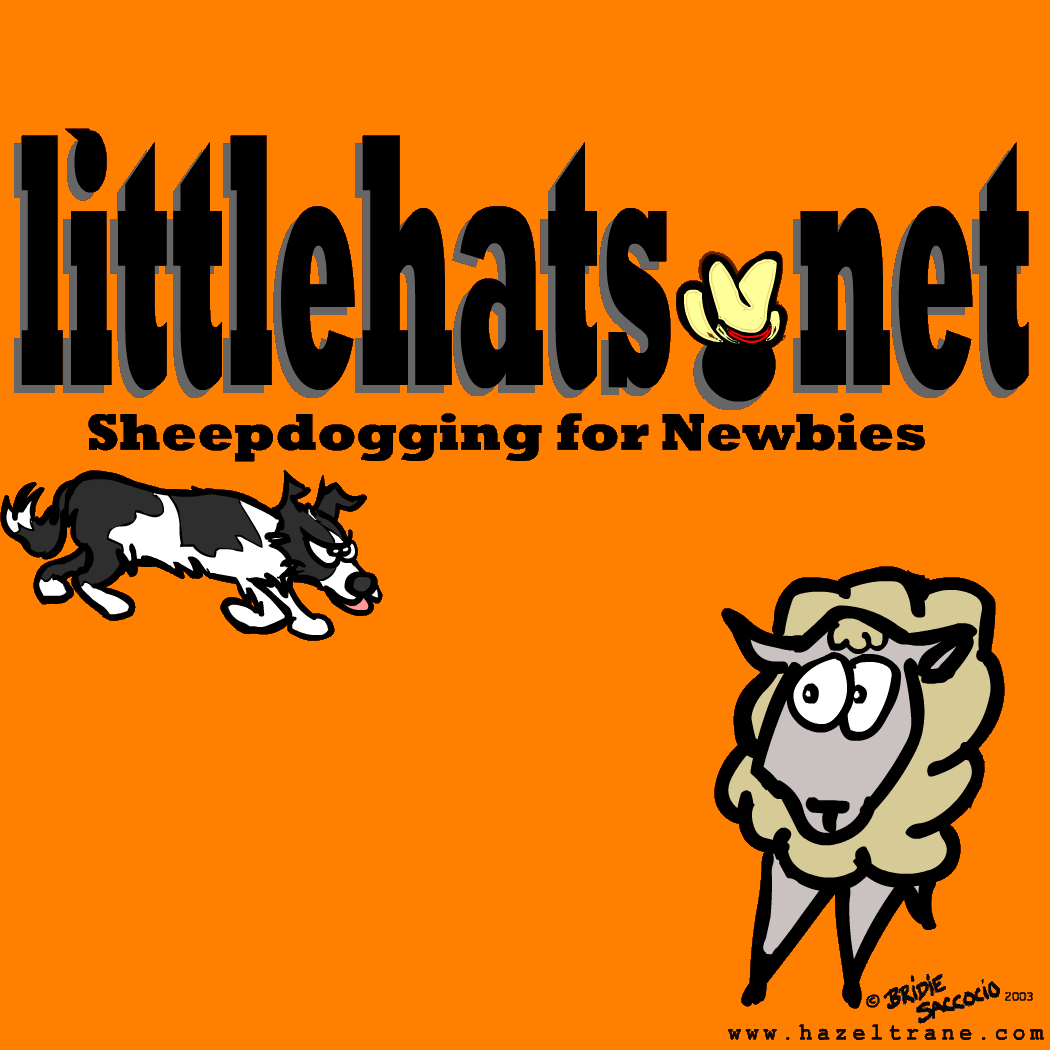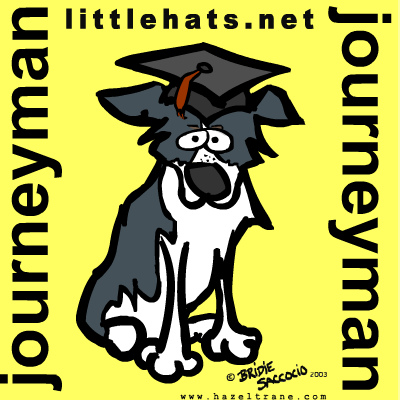


Reading Sheep
by Patrick Shannahan
Search This Site
Originally Published in American Border Collie Magazine. Reprinted with permission.
One of the most difficult tasks to teach students is the ability to "read" the sheep. Some people are more talented and able to pick up the ability easier, but it is difficult for most of us. A person who can "read" the sheep can flow through a course without causing the sheep to become upset, and make wild ewes look like it was their idea to go through the panels. I have been with livestock people who have a great proficiency to understand livestock, and I have been with some that despite their experience with livestock really don't have much of flair about livestock movements. At the same time, I have found that some rather inexperience students have picked up the concept quickly and transformed it into their trialing career. Working dog-broke livestock gives us all a chance to use this ability, but it is when we work unbroke livestock that the ability really begins to pay off.
My background with sheepdogs and trialing come from the opposite end of the scale than most of you. I was working livestock for many years before I got my first dog. This was a learning experience that I still find to be my most valuable asset. Work through these "dogless" years taught me that pressure and its subsequent release is what livestock understand in their movement habits.
During high school I had what I thought to be the perfect job, it was working at the salesyard on the weekends and some weekdays during the summer. Unloading, loading and penning the livestock was the main functions of the job, and of course there was no dog to help us. From this experience, I gained the knowledge of where to be to get livestock to move exactly where I wanted them. Unfortunately, most of us don't want to spend the time at a job like this, but the knowledge gained would put you on the path to a smoother transition with livestock.
After college, I started building my flock of sheep. Once again, I did it without the benefit of a dog. I ran sheep for a bout 6 years, building my numbers with a partner up to 250 ewes. Since I was the young person in the partnership, I did most of the physical work of getting the sheep and working them. We designed our facilities around not having a dog, with alleyways and closed chutes so the sheep couldn't escape. Serious trouble came when somehow the sheep got out of the pastures and we had to get them back in. Usually it took the help of friends and neighbors to get everyone in their right spot.
Then came the dogs…and of course everything changed for me. The work in the chutes that I was dreading became fun and exciting. Nothing was better than the partnership of me and the dog to work the sheep by ourselves. I started doing the routine vaccinations and worming on days that everyone else had to work. It had become much easier to do those jobs by myself with the help of a dog, than to have other people contaminate the system that the dog and I had worked out. My sheep partner actually became a little frustrated because I wasn't waiting for her to help with those jobs.
Now when I am helping students, I see a large number of them having difficulty making the leap from trainer to handler. To become a handler, the person needs to think about the sheep almost as much as they are thinking about the dog. Most of the students are afraid to take their eyes off their dog, and try and guess where approximately they should place their dog for the proper pressure. With livestock knowledge, you automatically have a good feeling of where to put the dog, and have figured out that it is okay to watch the livestock, as they can tell you what the dog is doing.
But it is a big transformation to be able to finally trust your dog and start watching the sheep. The easiest way that I have found to make that leap, is to set it up so you can't see your dog while it is working, but you can still see the sheep. Finding a pasture that is tall with grass or hay, I work my dog through in this situation. Usually with the tall grass, I am still able to see the sheep's heads, but I am unable to see the dog as they are working. From the movement of the sheep's heads, I am able to tell where my dog is and exactly what it is doing. This works throughout the fetch and driving. It will be difficult at first, but soon you will be able to read the sheep through watching their heads, and determining exactly what your dog is doing. Now once you get this down, you need to get different types of sheep and try this same experiment. Different sheep will react differently to the dog's movement of course.
Watching someone who has the concept of livestock reading down is a pleasure for us all. They are able to work the sheep or a cow without much stress and that is really what this whole message is about. If you are one that doesn't get a chance to utilize their livestock skills much, try working the livestock with out the dog. Their reactions might surprise you, and you might rethink some of the pressure that you are using in your handling. We all can't go back and spend the time I spent working without a dog, but we can work more diligently in trying to understand livestock and their movements.
My background with sheepdogs and trialing come from the opposite end of the scale than most of you. I was working livestock for many years before I got my first dog. This was a learning experience that I still find to be my most valuable asset. Work through these "dogless" years taught me that pressure and its subsequent release is what livestock understand in their movement habits.
During high school I had what I thought to be the perfect job, it was working at the salesyard on the weekends and some weekdays during the summer. Unloading, loading and penning the livestock was the main functions of the job, and of course there was no dog to help us. From this experience, I gained the knowledge of where to be to get livestock to move exactly where I wanted them. Unfortunately, most of us don't want to spend the time at a job like this, but the knowledge gained would put you on the path to a smoother transition with livestock.
After college, I started building my flock of sheep. Once again, I did it without the benefit of a dog. I ran sheep for a bout 6 years, building my numbers with a partner up to 250 ewes. Since I was the young person in the partnership, I did most of the physical work of getting the sheep and working them. We designed our facilities around not having a dog, with alleyways and closed chutes so the sheep couldn't escape. Serious trouble came when somehow the sheep got out of the pastures and we had to get them back in. Usually it took the help of friends and neighbors to get everyone in their right spot.
Then came the dogs…and of course everything changed for me. The work in the chutes that I was dreading became fun and exciting. Nothing was better than the partnership of me and the dog to work the sheep by ourselves. I started doing the routine vaccinations and worming on days that everyone else had to work. It had become much easier to do those jobs by myself with the help of a dog, than to have other people contaminate the system that the dog and I had worked out. My sheep partner actually became a little frustrated because I wasn't waiting for her to help with those jobs.
Now when I am helping students, I see a large number of them having difficulty making the leap from trainer to handler. To become a handler, the person needs to think about the sheep almost as much as they are thinking about the dog. Most of the students are afraid to take their eyes off their dog, and try and guess where approximately they should place their dog for the proper pressure. With livestock knowledge, you automatically have a good feeling of where to put the dog, and have figured out that it is okay to watch the livestock, as they can tell you what the dog is doing.
But it is a big transformation to be able to finally trust your dog and start watching the sheep. The easiest way that I have found to make that leap, is to set it up so you can't see your dog while it is working, but you can still see the sheep. Finding a pasture that is tall with grass or hay, I work my dog through in this situation. Usually with the tall grass, I am still able to see the sheep's heads, but I am unable to see the dog as they are working. From the movement of the sheep's heads, I am able to tell where my dog is and exactly what it is doing. This works throughout the fetch and driving. It will be difficult at first, but soon you will be able to read the sheep through watching their heads, and determining exactly what your dog is doing. Now once you get this down, you need to get different types of sheep and try this same experiment. Different sheep will react differently to the dog's movement of course.
Watching someone who has the concept of livestock reading down is a pleasure for us all. They are able to work the sheep or a cow without much stress and that is really what this whole message is about. If you are one that doesn't get a chance to utilize their livestock skills much, try working the livestock with out the dog. Their reactions might surprise you, and you might rethink some of the pressure that you are using in your handling. We all can't go back and spend the time I spent working without a dog, but we can work more diligently in trying to understand livestock and their movements.